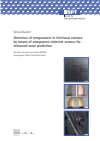Detection of temperature in frictional contact by means of component-inherent sensors for enhanced wear prediction
Zusammenfassung
Within the scope of this work conducted in the Collaborative Research Center 1368 »Oxygen-free production”, a new component-inherent sensor concept on non-planar surfaces is presented for measuring friction-induced temperature changes as a function of atmosphere, process parameters and ambient temperature during frictional ball-on-disc tests to improve wear prediction. The development and manufacturing of the platinum thin-film sensors on ceramic spheres via laser ablation involves the characterization of suitable sensor layouts, wear-resistant/isolation and friction layers. A laser structuring process is developed for machinable BN+AlN components to enable mechanical contacting of the sensors via the ball mount outside the friction contact area. Using an expanded measurement setup, friction tests are conducted under ambient atmosphere and under an atmosphere adequate to an extremely high vacuum using a silane-doped argon gas. To assess the fundamental effects of the friction-induced temperatures and their impact on resulting boundary layers, surface-sensitive analysis techniques are employed. Indentation tests are conducted in a high-temperature chamber to examine the thermomechanical properties in dependence of the surrounding atmosphere. The insights gained are utilized to expand the well known Archard wear model by including the dependence of the measured friction-induced temperature and atmosphere.
Schlagworte
- I–XX Titelei/Inhaltsverzeichnis I–XX
- 1–3 1. Introduccion 1–3
- 4–14 2. Fundamentals 4–14
- 2.1 Introduction of friction and frictional contacts
- 2.2 Wear mechanisms
- 2.3 Influences on friction and wear
- 2.4 Mathematical modelling of wear
- 15–31 3. State of the Art 15–31
- 3.1 Tribometer
- 3.2 Overview of analytical wear models
- 3.3 Mathematical contact and flash temperature models
- 3.5 Temperature measurement methods in frictional contacts
- 3.6 Laser technology for sensor production
- 3.7 Laser direct structuring on ceramics
- 32–36 4 Scope of Work 32–36
- 4.1 Initial situation
- 4.2 Research questions
- 4.3 Task and objective
- 4.4 Approach
- 37–45 5 Technologies and Materials for Fabrication and Characterization 37–45
- 5.1 XHV-adequate atmosphere
- 5.2 Universal Mechanical Tester (UMT)
- 5.3 Cathode sputtering system
- 5.4 Analysis and characterization
- 5.5 Thermal stress analysis
- 5.6 Sensor production and contacting
- 5.7 Electrical measurements and characterization
- 5.8 Analytical modelling and simulation
- 5.9 Adhesive strength analysis
- 5.10 Sensor parameters
- 5.11 Properties of technical ceramics
- 46–67 6 Sensor Development 46–67
- 6.1 Experimental boundary conditions
- 6.2 Material selection and sensor design
- 6.3 Selective laser ablation of the sensor structure
- 6.4 Characterization of the component inherent sensors
- 6.5 Interim summary of the sensor development
- 68–85 7 Contacting by means of Laser Direct Structuriung 68–85
- 7.1 Process development of laser direct structuring on ceramic materials
- 7.2 Contacting
- 7.3 Transfer of the developed process to a machinable ceramic material
- 7.4 Characterization of the conductive tracks
- 7.5 Interim summary - LDS on ceramic substrates
- 7.6 Production and metallization of the ceramic sphere holder
- 86–109 8 Integration and Measurement 86–109
- 8.1 Integration
- 8.2 Experimental set-up
- 8.3 Results and discussion of the measurements
- 8.4 Comparison to mathematical results
- 8.5 Summary and discussion of the results
- 110–126 9 Extension of the Wear Model 110–126
- 9.1 Real contact area
- 9.2 Friction induced temperature
- 9.3 Mechanical and tribological properties
- 9.4 Wear calculation
- 9.5 Experimental validation of the model
- 127–130 10 Concluding, Remarks and Perspektives 127–130
- 131–142 APPENDIX 131–142
- A.1 Appendix I : Overview of the scope of work for the sensor production
- A.2 Appendix II - XHV-adequate atmosphere
- A.3 Appendix III - Results temperature measurements
- A.4 Appendix IV - Additional measurement attempts
- A.5 Preliminary simulations
- A.6 Appendix V - xSol
- A.7 Appendix VI - Samples after the friction tests
- A.8 Appendix VII - Overview of the mathematical model
- A.9 Appendix VIII - First preliminary tests on glass
- 143–173 Bibliography 143–173


